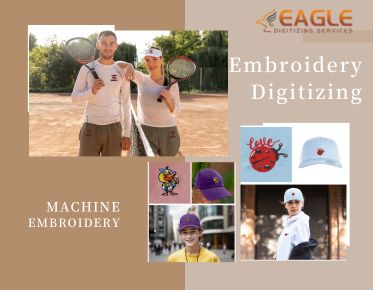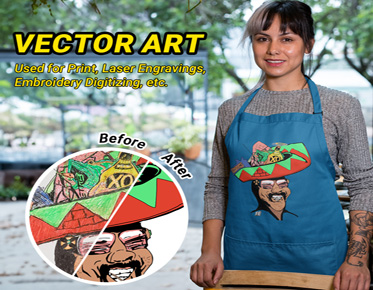Must-Know Trends in Digitized Embroidery
As digitized embroidery continues to push artistic and
technological boundaries, it’s clear that this isn’t your grandmother’s
needlework. Today, embroidery is not only a craft but a canvas for innovation,
where digital tools meet traditional methods to create remarkable designs.
Keeping up with current trends isn’t just about staying modern; it’s about
discovering new techniques that can transform ordinary stitches into
extraordinary masterpieces. From high-tech fabrics to unexpected materials,
let’s delve into the trends shaping the future of embroidery.
3D Embroidery: Taking Designs to New Heights
What
3D Embroidery Is and How It Works
3D embroidery
isn’t merely stitching; it’s sculpting with thread. This technique adds depth
and volume, creating raised patterns that seem to pop off the fabric. Using
specialized threads and foam layers, 3D embroidery allows for a textured effect
that adds dimension to logos, lettering, and even intricate designs. This
technique combines traditional stitchwork with an innovative twist, making every
piece a tactile experience.
Tips
for Incorporating 3D Elements into Your Projects
To incorporate 3D
elements, consider using bold, high-contrast colors that emphasize the depth of
the design. Focus on larger, less intricate patterns, as smaller details may
lose definition with added thickness. Experimenting with different thread
weights and densities also enhances the 3D effect, making the design truly
stand out.
Popular
3D Embroidery Projects to Try
From baseball
caps to branded apparel, 3D embroidery is
popular in fashion and streetwear. Try it on personal items like backpacks or
even home decor, where raised floral or geometric designs can add a unique
touch to pillows or wall hangings.
Interactive and Smart Wearable Embroidery
Combining
Embroidery with Smart Textiles
Smart textiles
are opening up an exciting intersection between wearable tech and embroidery.
Imagine jackets with threads that light up, or scarves that can monitor heart
rate—embroidery is stepping into the tech world with functional aesthetics. By
embedding conductive threads, embroidery can now support everything from
touch-sensitive surfaces to interactive displays.
How
Digitized Embroidery is Enhancing Wearable Tech
With advancements
in digital embroidery, designers can integrate
technology seamlessly into their creations. This allows for designs that don’t
just look great but also serve a purpose, from LED-illuminated stitching to
reactive materials that respond to touch.
Examples
of Fun and Functional Embroidered Smart Clothing
LED-stitched
jackets, temperature-reactive scarves, and even Wi-Fi-enabled caps are just a
few of the innovations popping up. These creations bring together tech and
textiles, proving that embroidery isn’t only about looks; it’s also about
enhancing life in unexpected ways.
Hyper-Realistic Embroidery
Creating
Embroidery That Looks Like Paintings
Hyper-realistic
embroidery turns fabric into a canvas for photorealistic art. By carefully layering
stitches in varied hues and directions, skilled embroiderers can achieve
shading and depth that mimic brushstrokes. This technique brings portraits and
landscapes to life with astonishing realism.
The
Art of Shading and Layering for Photorealistic Results
Achieving a
realistic look requires patience and skill in layering. Start with a light base
and build colors gradually, focusing on stitch direction to create shadows and
highlights. This technique requires a steady hand and a sharp eye for detail, but
the results are breathtaking.
Tools
and Techniques for Achieving a Realistic Finish
Tools like
embroidery hoops, high-quality threads, and digital design software are
essential for producing realistic finishes. Using variegated thread also helps
add subtle changes in color, while embroidery software with realistic previews
makes it easier to perfect each layer before stitching.
Personalization and Customization at Scale
The
Popularity of Monograms and Custom Names
Personalization
is no longer reserved for the elite—monograms, custom names, and unique
initials are back in style, making their way onto everything from towels to
tote bags. Digitized embroidery has made it easier to add these custom touches,
allowing anyone to create items that feel truly personal.
How
Digitized Embroidery is Making Personalization Easier
With digitized
embroidery, users can easily upload and adjust designs, making customization a
breeze. Whether you want to add a loved one’s name to a pillow or create
matching team caps, digitized patterns simplify the process and make it
accessible for every skill level.
Ideas
for Adding Personalized Touches to Everyday Items
Consider adding
initials to fabric coasters, creating personalized aprons for gifts, or
embellishing denim jackets with individual patches. Personalized embroidery can
elevate even the simplest items, transforming everyday objects into thoughtful
keepsakes.
Minimalist and Modern Design Trends
The
Shift from Intricate to Minimalist Patterns
In the past,
embroidery was known for elaborate, detailed patterns. Today, there’s a shift
toward simplicity, with clean lines, minimalist shapes, and understated designs
taking center stage. Minimalist embroidery emphasizes balance and
intentionality, creating subtle but striking pieces.
Why
Simple Shapes and Lines Are the New Favorite
Minimalist
designs are versatile, complementing both modern and traditional aesthetics.
Simple shapes and clean lines are less time-intensive yet remain elegant,
offering an easy entry point for beginners and a refined style for advanced
artists.
Designing
Your Own Modern, Minimalist Patterns
Minimalist
patterns allow for self-expression without clutter. Start by sketching basic
geometric shapes, then experiment with spacing and orientation. Choose muted
colors or monochromatic palettes for an effortlessly modern touch.
The Return of Vintage and Retro Patterns
Why
Retro Embroidery is Making a Comeback
Vintage and retro
designs bring nostalgia to modern embroidery, giving projects a timeless charm.
Floral motifs, Art Deco-inspired patterns, and mid-century designs are
especially popular as they add a classic touch to home decor and fashion.
Finding
and Digitizing Vintage Patterns for Modern Use
Many online
libraries offer downloadable vintage patterns, or you can digitize your own by
scanning old embroidery books or personal sketches. Digitizing these designs
allows them to be stitched with modern embroidery machines, blending the old
with the new.
Tips
for Mixing Vintage Flair with Contemporary Designs
Try combining
retro designs with bold colors or placing traditional patterns on unexpected
items. Adding a classic floral design to a denim jacket, for example, is a unique
way to bring a vintage vibe into a contemporary look.
Glow-in-the-Dark and Neon Threads
How
to Use Glow-in-the-Dark Threads for a Unique Effect
Glow-in-the-dark
threads create a whimsical and ethereal effect, adding an extra layer of
intrigue to embroidery. Ideal for children’s clothing, night-time accessories,
or Halloween decorations, these threads add a surprise element that lights up
in the dark.
The
Growing Appeal of Neon-Colored Embroidery
Neon threads
offer a vibrant pop of color that stands out, especially on dark fabrics. This
bold choice is ideal for streetwear, festival clothing, and other high-energy
items, bringing attention-grabbing detail to each stitch.
Projects
That Shine (Literally) with Glow and Neon
From backpacks to
beanies, glow-in-the-dark, and neon threads are popular for youth accessories.
They also work beautifully on sportswear or any design where high visibility
and playful color make an impact.
Mixed Media Embroidery
Combining
Digitized Embroidery with Fabric Paints and Beads
Mixed media
embroidery opens up a world of texture and color, combining stitches with
materials like paint, beads, and sequins. This approach allows artists to
create intricate, multidimensional pieces that defy traditional embroidery.
Exploring
the World of Embroidery and Appliqué Hybrids
Appliqué combined
with embroidery introduces patterns and textures in new ways, layering fabrics
with stitched designs for a visually rich
effect. This technique is ideal for adding depth and a hand-crafted feel to
garments and home decor.
How
Mixed Media is Making Embroidery More Dynamic
Mixed media
embroidery transforms designs into tactile, sensory experiences. By blending
materials and techniques, artists can create unique and captivating
compositions that break free from traditional flat stitching.
Sustainable Embroidery Techniques
The
Benefits of Slow Stitching in a Fast-Paced World
Slow stitching
emphasizes mindful creation, focusing on quality and craftsmanship over speed.
This approach values intentional design, allowing crafters to immerse
themselves in the joy of embroidery, creating heirloom-quality pieces with each
careful stitch.
Using
Water-Soluble Stabilizers for Eco-Conscious Crafting
Water-soluble
stabilizers support sustainable embroidery by reducing waste. Once the
embroidery is complete, the stabilizer dissolves in water, leaving behind no
residue and eliminating disposable waste.
Reusing
and Upcycling Fabric Scraps
Repurposing
fabric scraps for small embroidery projects is both eco-friendly and
cost-effective. From scrap patches to mini wall hangings, upcycling fabrics
offer creative ways to reduce waste and give new life to old materials.
Virtual Reality (VR) and Augmented Reality (AR) in Embroidery Design
How
VR and AR are Changing the Design Process
VR and AR are
bringing embroidery into the virtual realm, allowing designers to visualize
patterns in a 3D environment before stitching. This technology aids in pattern
accuracy and offers a new dimension of design planning, making it easier to
visualize large or intricate projects.
Using
AR to Visualize Embroidery Before You Stitch
With AR apps,
embroiderers can preview designs on garments or accessories in real-time. This
tool is especially helpful for customizing placement and scale, enabling
creators to perfect designs before committing to stitches.
The
Future of Interactive Embroidery Patterns
The future holds
exciting possibilities with interactive patterns, where VR and AR could allow
for digital “stitch guides” that overlay on fabric, guiding embroiderers
through complex designs.
Customization Through Software Advancements
Exploring
the Latest Embroidery Software Features
Today’s
embroidery software is packed with features like auto-digitizing, color
mapping, and realistic previews. These tools make designing and adjusting
patterns easier than ever, with instant editing options that allow users to
perfect their work before stitching.
Using
AI-Based Design Tools for Instant Adjustments
AI-powered design
tools offer real-time suggestions, adjusting colors, scaling, and stitch types
automatically. These tools streamline the creative process, helping users
achieve their vision with minimal manual input.
Tips
for Maximizing Software to Create One-of-a-Kind Designs
Experimenting
with software features is key to maximizing its potential. Layer effects,
experiment with color gradients, or explore custom stitch fills for a signature
look that reflects individual creativity.
Color-Changing Threads and Heat-Activated Designs
The
Magic of Threads That Change Colors with Temperature
Color-changing
threads add an element of surprise, reacting to temperature shifts and
transforming colors. These threads are especially popular for accessories and
kids’ items, making designs interactive and unique.
Using
Heat-Activated Techniques to Add a Surprise Element
Heat-activated
designs bring out hidden details when exposed to heat, creating a magical
reveal. This technique is ideal for personalized gifts or novelty items, adding
a touch of wonder to every stitch.
Best
Practices for Projects That React to Heat and Light
Testing is
essential with reactive threads and heat-sensitive materials. Practicing on
scrap fabric first ensures that the color change or design reveal is seamless,
bringing the intended effect to life.
In a world where craft and technology converge, digitized embroidery is constantly evolving. These trends are just the beginning of an exciting journey, one where creativity, tradition, and innovation coalesce to redefine what embroidery can be. Embracing these trends means staying at the forefront of this creative transformation, exploring new techniques, and, ultimately, weaving stories through stitches that go beyond the fabric.



.png)